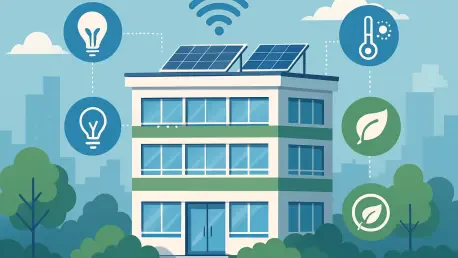In a world grappling with the escalating crisis of climate change, commercial buildings stand out as both a significant challenge and a promising opportunity for reducing carbon emissions. According to the International Energy Agency, these structures account for a staggering 30% of global energy consumption and 26% of energy-related emissions, with offices and warehouses alone contributing up to 8% of energy use and 10% of emissions. This immense environmental footprint underscores an urgent need to rethink how buildings operate, moving away from energy-intensive designs toward intelligent systems that prioritize sustainability without compromising occupant comfort. The potential for transformation is vast, and technology is paving the way for a revolution in energy management.
The rise of smart building solutions, fueled by the Internet of Things (IoT), offers a compelling path forward for modern architecture and energy management. These innovations enable buildings to shift from passive energy consumers to active participants in energy ecosystems, leveraging tools like real-time monitoring, seamless device communication, and electric vehicle (EV) integration. Imagine a structure that instinctively adjusts lighting and heating based on occupancy or even shares stored power with the grid during peak demand. This is no longer a distant vision but a tangible reality, driven by cutting-edge advancements that promise not only lower utility costs but also a significantly reduced carbon footprint. As the built environment evolves, the focus is on creating spaces that are both efficient and responsive to broader sustainability goals.
The Urgency of Energy Efficiency in Buildings
Addressing a Critical Environmental Impact
The scale of energy consumption in commercial buildings presents a pressing environmental challenge that demands immediate and innovative action. Offices and warehouses, as key contributors to global energy use, are responsible for substantial greenhouse gas emissions, making them prime targets for efficiency upgrades. With growing urbanization and increasing demand for commercial space, the environmental stakes continue to rise, amplifying the need for solutions that can curb energy waste. Smart technology emerges as a powerful ally in this effort, offering tools to drastically reduce consumption while aligning with operational needs. By targeting inefficiencies in heating, cooling, and lighting—often the largest energy drains—buildings can achieve significant reductions in their carbon output. This shift is not merely a trend but a critical step toward meeting global decarbonization targets, ensuring that the built environment plays a constructive role in combating climate change.
Beyond the environmental imperative, there is also a strong economic case for energy efficiency in buildings, as high energy consumption translates directly into elevated operational costs, burdening businesses with expenses that could be mitigated through smarter systems. Implementing intelligent energy management not only cuts utility bills but also enhances property value by appealing to environmentally conscious tenants and investors. Moreover, regulatory pressures are mounting, with governments worldwide imposing stricter standards on building emissions and energy use. Adopting smart solutions now positions building owners to stay ahead of compliance requirements, avoiding potential penalties while contributing to a sustainable future. The convergence of environmental, financial, and regulatory drivers makes the case for energy-efficient buildings undeniable, setting the stage for widespread adoption of transformative technologies.
Building a Foundation for Systemic Change
Tackling energy inefficiency in buildings goes beyond individual structures; it lays the groundwork for broader systemic improvements in how energy is managed globally. Commercial spaces, when optimized, can serve as models for residential and industrial sectors, demonstrating the scalability of smart technologies in diverse settings. This ripple effect is crucial, as buildings interact with and influence the larger energy grid, impacting overall demand and stability. By reducing peak loads and integrating renewable sources, these structures help alleviate strain on infrastructure, fostering a more resilient energy network. The potential for buildings to act as microcosms of sustainability offers valuable lessons for policymakers and urban planners aiming to design low-carbon cities. As such, the focus on energy efficiency in commercial buildings becomes a cornerstone of a larger movement toward decarbonization, with far-reaching implications for global energy strategies.
The urgency of this transformation is further highlighted by the accelerating pace of climate-related disruptions, which underscore the need for immediate action in high-impact sectors like construction and real estate. Smart building technologies provide a practical means to address these challenges, enabling real-time adjustments that prevent energy waste before it accumulates into larger environmental harm. Additionally, the data gathered from efficient buildings can inform future innovations, creating a feedback loop that continuously refines energy management practices. This dynamic approach ensures that solutions remain relevant amid evolving environmental and technological landscapes. By prioritizing energy efficiency now, the building sector can lead by example, inspiring cross-industry efforts to reduce carbon footprints and build a more sustainable world for future generations.
IoT and Interoperability as Game-Changers
Breaking Down Silos with Matter Standard
A fundamental barrier to energy efficiency in buildings has long been the lack of communication between disparate systems like lighting, HVAC, and security, each often operating in isolation due to incompatible protocols. The Matter standard, championed by the Connectivity Standards Alliance, addresses this challenge head-on by enabling seamless interoperability among devices from various manufacturers. This means a motion sensor can trigger lights to turn off in an empty room while simultaneously signaling a thermostat to adjust temperature settings, all without the need for custom integrations. Such coordination eliminates redundant energy use, ensuring that systems work in harmony to optimize consumption. The beauty of this standard lies in its ability to simplify complex interactions, making smart buildings more accessible and effective for managers seeking to reduce operational waste while maintaining a comfortable environment for occupants.
The impact of interoperable systems extends beyond immediate energy savings to influence long-term building design and management strategies. With devices communicating effortlessly, building operators can implement holistic energy plans that adapt to changing conditions without requiring constant manual oversight. For instance, during periods of low occupancy, an integrated system might scale back multiple functions simultaneously, from dimming lights to reducing ventilation, achieving compounded savings. This level of coordination also fosters innovation, as developers can focus on creating specialized devices knowing they will integrate smoothly into existing networks. As more buildings adopt this standard, the collective reduction in energy waste could have a profound effect on global emission levels, positioning interoperability as a linchpin in the quest for sustainable infrastructure.
Real-Time Decisions for Optimal Performance
The ability to make instantaneous decisions based on current conditions sets modern smart buildings apart from their traditional counterparts, largely thanks to local network communication enabled by IoT platforms. Unlike older setups where systems functioned independently, often leading to delayed or inefficient responses, today’s interconnected environments allow for rapid adjustments that save energy in real time. A sudden drop in occupancy, for example, can prompt an immediate reduction in HVAC output and lighting intensity, preventing unnecessary consumption. This responsiveness ensures that energy is allocated precisely where and when it’s needed, minimizing waste while enhancing occupant comfort. The speed and precision of these decisions mark a significant leap forward in building management, aligning operational efficiency with environmental goals.
Moreover, real-time decision-making through IoT connectivity empowers building managers with actionable insights that were previously unattainable due to fragmented data sources. By centralizing information from various systems into a unified platform, managers can observe how different components interact and affect overall energy use, enabling proactive adjustments. For instance, if a particular zone consistently shows high energy draw during off-hours, swift corrective measures can be taken to address underlying issues like faulty equipment or scheduling errors. This dynamic approach not only curbs inefficiencies but also builds a culture of continuous improvement in energy management. As IoT technology evolves, its capacity to facilitate such immediate, informed decisions will likely become even more integral to creating buildings that are both sustainable and adaptable to future demands.
Sensor-Driven Automation and Monitoring
Ambient Sensing for Dynamic Adjustments
At the heart of smart building efficiency lies ambient sensing, a technology that equips structures with the ability to perceive and react to their environments in real time. Sensors for occupancy, temperature, humidity, light levels, and air quality continuously collect data, acting as the sensory framework that informs automated systems. When a room is unoccupied, for instance, these sensors signal lighting to dim and HVAC systems to scale back, ensuring energy isn’t wasted on empty spaces. Advanced tools like ultra-wideband (UWB) sensors take this further by accurately counting occupants without infringing on privacy, allowing for precise adjustments based on actual usage. This capability to dynamically adapt to changing conditions eliminates the inefficiencies of static schedules, marking a significant shift toward energy-conscious building operations that prioritize both sustainability and occupant well-being.
The benefits of ambient sensing extend into creating healthier indoor environments, which indirectly supports energy efficiency by optimizing system performance. Poor air quality or uncomfortable temperatures often lead to overcompensation by HVAC systems, driving up energy use unnecessarily. By maintaining ideal conditions through constant monitoring, sensors prevent such wasteful cycles, ensuring systems run only as needed. For example, if carbon dioxide levels rise in a crowded meeting room, ventilation can increase automatically to maintain air quality without affecting other areas. This targeted approach reduces overall energy draw while improving the occupant experience, demonstrating how automation can balance environmental and human needs. As sensor technology advances, its integration into building design will likely become even more seamless, further refining the balance between efficiency and comfort.
Energy Monitoring for Informed Choices
Visibility into energy consumption patterns is a critical component of effective building management, adhering to the principle that measurement is the first step to improvement. Real-time energy monitoring, enabled by IoT-connected devices, provides granular data on usage across all systems, from large HVAC units to small office appliances. This transparency allows managers to identify high-consumption areas or wasteful habits, such as lights left on during non-working hours, and address them promptly. The ability to see exactly where and how energy is used empowers informed decision-making, enabling quick fixes that prevent small inefficiencies from compounding into significant waste. Such detailed insights are indispensable for crafting strategies that align operational needs with sustainability objectives, ensuring resources are allocated efficiently.
Beyond immediate corrections, energy monitoring supports long-term planning by revealing trends that guide strategic investments in efficiency upgrades. For instance, consistent spikes in energy use during specific times might indicate the need for equipment upgrades or schedule adjustments, such as shifting high-energy tasks to off-peak hours when utility rates are lower. This data-driven approach not only reduces costs but also minimizes emissions by optimizing consumption patterns to align with grid stability needs. Furthermore, the insights gained can be shared with stakeholders to build support for broader sustainability initiatives, fostering a collaborative effort to reduce environmental impact. As monitoring technology becomes more sophisticated, its role in shaping energy-efficient building practices will continue to grow, providing a foundation for continuous improvement in resource management.
Device Coordination and Grid Interaction
Balancing Loads Through Collaboration
The power of smart buildings lies in their ability to coordinate multiple systems as a cohesive unit, ensuring energy use is balanced and optimized even during high-demand scenarios. When devices like HVAC, lighting, and server racks are interconnected, they can dynamically adjust operations to prioritize critical functions while scaling back non-essential ones. During utility demand-response events or periods of elevated pricing, for example, a building might automatically dim lights, adjust thermostat settings, or temporarily pause EV charging to reduce peak load. This collaborative approach not only cuts energy waste but also flattens load curves, preventing sudden spikes that strain the grid and drive up costs. By working in unison, these systems create an environment where efficiency is embedded into every operation, supporting both financial and environmental goals.
This level of coordination also enhances a building’s ability to adapt to external pressures without disrupting core functions, ensuring operational reliability. For instance, during a heatwave when cooling demands surge, a smart system might redistribute energy by limiting non-critical lighting or equipment use, maintaining comfort in occupied areas without overloading capacity. Such flexibility is particularly valuable in commercial settings where downtime or discomfort can impact productivity and tenant satisfaction. Additionally, coordinated systems provide a buffer against unexpected disruptions, such as power outages, by intelligently managing limited resources until normal conditions resume. As more buildings adopt this integrated approach, the cumulative effect on energy demand could significantly alleviate pressure on regional grids, paving the way for a more stable and sustainable energy landscape.
Supporting the Grid with Smart Responses
Smart buildings are redefining their role in the energy ecosystem by actively supporting grid stability through responsive energy management. Equipped with battery storage, these structures can capture excess energy during low-demand periods or from onsite renewable sources like solar panels, then release it back to the grid during peak times. By responding to grid signals—such as requests to reduce consumption during shortages—they help balance supply and demand, mitigating the risk of blackouts or brownouts. This active participation transforms buildings from mere consumers into vital partners in maintaining a reliable energy network, contributing to broader decarbonization efforts. The ability to store and share energy also reduces reliance on fossil fuel-based backup systems, further lowering emissions across the system.
The implications of this grid interaction extend to fostering a more decentralized energy model, which is essential for long-term sustainability, and smart buildings play a crucial role in this transformation. By acting as distributed energy resources, smart buildings help reduce the need for centralized power plants that often rely on carbon-intensive fuels. For example, during extreme weather events when grid demand spikes, a network of smart buildings can collectively supply stored energy, easing the burden on traditional infrastructure. This shift not only enhances resilience against climate-driven disruptions but also encourages the integration of renewable energy by providing a buffer for its intermittent nature. As technology advances, the potential for buildings to play an even larger role in grid support will grow, solidifying their position as key players in the transition to a cleaner, more flexible energy future.
Electric Vehicles and Future Energy Roles
Managing EV Charging for Minimal Strain
As electric vehicles (EVs) become increasingly common, their integration into building energy systems presents both challenges and opportunities for efficiency, especially as the demand for sustainable solutions grows. Unmanaged EV charging can create significant power spikes, particularly if multiple vehicles charge simultaneously during peak hours, straining both building systems and the broader grid. Smart buildings address this by scheduling charging during low-demand or low-cost periods, ensuring minimal disruption to energy balance. Advanced management systems can even prioritize charging based on vehicle needs or departure times, optimizing resource allocation. This thoughtful approach not only prevents grid overload but also supports the growing shift toward cleaner transportation by making EV adoption more practical for commercial properties, aligning infrastructure with environmental priorities.
The benefits of managed EV charging extend to cost savings and improved tenant satisfaction, which are critical for building operators in competitive markets. By leveraging off-peak rates, property managers can significantly reduce the expense of powering EV stations, passing savings on to users or reinvesting them into further efficiency upgrades. Additionally, providing reliable and efficient charging options enhances the appeal of a building to eco-conscious businesses and employees, positioning it as a forward-thinking space. This integration also prepares buildings for future regulatory shifts, as policies increasingly incentivize or mandate EV infrastructure in commercial settings. As the number of EVs continues to rise, smart charging solutions will become an essential component of building design, ensuring compatibility with evolving energy and transportation landscapes.
Vehicle-to-Grid as an Energy Asset
Vehicle-to-grid (V2G) technology represents a groundbreaking step in redefining the energy role of buildings by turning EV parking areas into dynamic storage hubs. This innovation allows electric vehicles to not only draw power for charging but also return stored energy to the building or grid during peak demand periods, effectively acting as mobile batteries. Supported by unified IoT platforms, V2G enables seamless bidirectional energy flow, ensuring that power is available exactly when and where it’s needed most. For instance, during a grid shortage, EVs parked at an office can supply electricity to keep critical systems running, reducing reliance on external sources. This capability transforms buildings into active energy contributors, enhancing both resilience and sustainability in the face of fluctuating energy demands.
The potential of Vehicle-to-Grid (V2G) technology extends beyond immediate grid support to influence long-term energy planning and policy, shaping a more sustainable future. By aggregating the storage capacity of multiple vehicles, buildings can participate in energy markets, selling excess power back to utilities during high-price periods and generating additional revenue streams. This economic incentive could accelerate the adoption of electric vehicles (EVs) and smart building technologies, creating a virtuous cycle of investment in sustainable infrastructure. Furthermore, V2G systems help mitigate the intermittency of renewable energy sources by storing surplus generation for later use, smoothing out supply inconsistencies. As this technology matures, its integration into building energy systems will likely become a standard feature, fundamentally altering how energy is managed and distributed in urban environments.
Buildings as Pillars of Decentralized Energy
The ultimate vision for smart buildings is their evolution into central components of a decentralized energy network, fundamentally reshaping the traditional power grid model. By incorporating battery storage and renewable energy sources like solar, these structures can capture and store surplus power during off-peak times or high generation periods, then release it when demand spikes or supply falls short. Through mechanisms like building-to-grid interactions and vehicle-to-grid (V2G) technology, they actively contribute to grid stability, reducing dependence on centralized, often carbon-heavy power plants. This shift toward decentralization enhances energy resilience, particularly in the face of natural disasters or infrastructure failures, ensuring communities have access to reliable power. Smart buildings, in this role, become indispensable to achieving global sustainability targets, bridging the gap between local efficiency and systemic change.
This transformation also fosters a more equitable and flexible energy landscape, empowering individual buildings to play a significant role in broader environmental goals. By responding to grid signals and adjusting consumption or supply accordingly, smart structures help balance regional energy loads, preventing overuse of resources in one area while shortages occur in another. This adaptability is particularly crucial as renewable energy adoption grows, requiring a network capable of handling variable inputs like wind or solar power. Additionally, the data generated from these interactions can inform utility providers and policymakers, driving smarter investments in grid modernization. As more buildings adopt these capabilities, the collective impact will likely accelerate the transition to a low-carbon economy, positioning the built environment as a cornerstone of sustainable progress.









